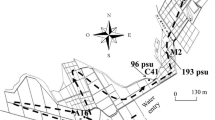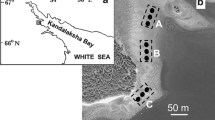Abstract
Continuous abundance estimates (510 m resolution) of the copepods Neocalanus cristatus, N. flemingeri and Metridia pacifica were obtained with an electronic particle counter along cruise tracks in the subarctic western North Pacific in spring. For all three species, the number of patches decreased exponentially with increasing patch size. Most patches (63 to 83%) were dominated by one species, and patches of the same species more closely spaced than patches of different species. The patches of M. pacifica tended to coexist with those of N. cristatus. In contrast, patches of N. flemingeri rarely co-occurred with those of other copepods. These patterns were more clearly observed in fine-scale observations with sampling intervals of <31 m. Coherence analysis of copepod species pairs showed no characteristic scale at 2 to 50 km wave lengths. At shorter wave lengths (<2 km), frequent positive correlations were observed between N. cristatus and M. pacifica. Thus, the distribution of copepods appears to be a mosaic assemblage of patches of each copepod species. These results suggest that copepods have a mechanism to form species-specific aggregations, and the aggregation and segregation processes are maintained at a scale of <2 km.
Similar content being viewed by others
Author information
Authors and Affiliations
Additional information
Received: 24 February 1999 / Accepted: 25 April 2000
Rights and permissions
About this article
Cite this article
Tsuda, A., Sugisaki, H. & Kimura, S. Mosaic horizontal distributions of three species of copepods in the subarctic Pacific during spring. Marine Biology 137, 683–689 (2000). https://doi.org/10.1007/s002270000338
Issue Date:
DOI: https://doi.org/10.1007/s002270000338




